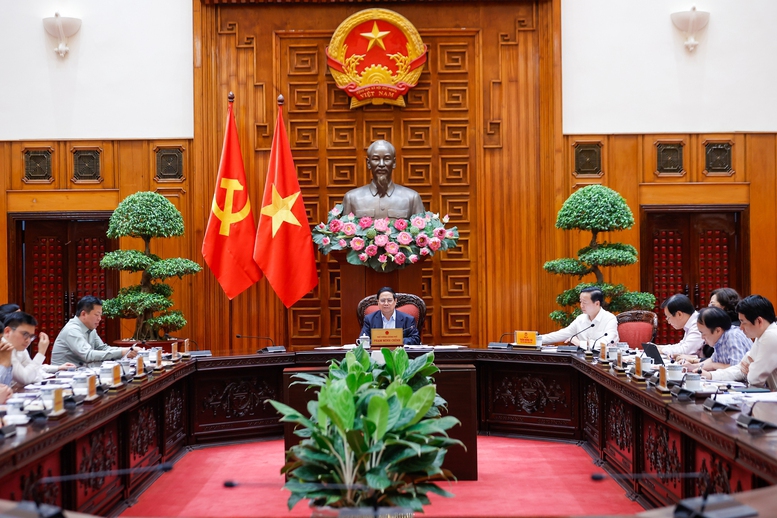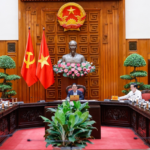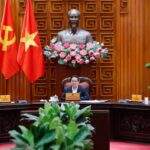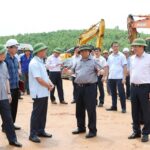
Prime Minister Pham Minh Chinh chairs the meeting on May 20 with relevant ministries and agencies to review the implementation of railway projects connecting Vietnam and China – Photo: VGP/Nhat Bac
Prime Minister Pham Minh Chinh applauded the efforts of the Ministry of Construction and related agencies in carrying out the tasks assigned by the Prime Minister and Deputy Prime Minister Tran Hong Ha. Significant progress has been made so far. All railway projects involve large-scale construction, advanced technology, and complex engineering. Therefore, the implementation process demands tremendous effort from the involved ministries, local authorities, and units. It is crucial to instill a strong sense of unity, determination, and dedication throughout the process, ensuring that each task is executed with precision and decisiveness. The delegation of responsibilities must be crystal clear, with specific individuals assigned to each task, along with defined timelines, accountability, outcomes, and authority.
Commencement of the Lao Cai – Hanoi – Haiphong Railway Project on December 19, 2025
The Prime Minister instructed the Ministry of Construction to promptly develop a detailed timeline for the project’s tasks, based on the directives outlined in Resolution No. 127/NQ-CP dated May 13, 2025, and the scheduled commencement date of December 19, 2025 (simultaneously at five locations). This timeline should include specific assignments for each relevant ministry, sector, and locality, to be completed by the end of May 2025. The Ministry of Construction is also tasked with finalizing the approved route in collaboration with local authorities and completing land clearance by the end of May 2025.
Additionally, the ministry should expedite the completion of standard translation for the project and establish a comprehensive system of norms and standards (to be finalized by the end of May 2025), as per the Prime Minister’s directives in Conclusion Report No. 213/TB-VPCP dated May 4, 2025.
Regarding the loan agreement, the Ministry of Finance, in coordination with the Ministry of Construction and the Ministry of Foreign Affairs, should expedite the negotiation process to ensure the earliest possible signing of the agreement, preferably by August 2025.
On Technology Transfer, Human Resource Training, and Railway Industry Development: Technology transfer is mandatory as per the requirements of the competent authority. The Ministry of Construction, in collaboration with the Ministry of Science and Technology, the Ministry of Finance, the Ministry of Industry and Trade, and the Ministry of Foreign Affairs, should proactively engage with the Chinese side on the technology transfer plan. This should be completed by June 20, 2025, with timely reports to the Prime Minister and competent authorities regarding any difficulties or obstacles encountered.
The Ministry of Construction, in coordination with the Ministry of Education and Training, is tasked with finalizing the human resource development plan, clearly outlining the requirements and training plans for engineers, workers, and doctoral candidates, to be completed by June 2025.
The Ministry of Industry and Trade is instructed to expedite the completion of the railway industry development plan as assigned by the Government in Resolution No. 127/NQ-CP dated May 13, 2025, with a deadline of June 2025.
Compensation, Support, and Resettlement for the Project: The Ministry of Agriculture and Environment is responsible for guiding local authorities on matters related to compensation, support, and resettlement, as well as facilitating the conversion of forest, land, and rice field usage.
The Ministry of National Defense should proactively survey defense-related structures and lands that need to be relocated due to the project, providing support and cooperation to ensure smooth relocation.
Local authorities and the Vietnam Electricity Group are urged to decisively carry out the tasks assigned in Dispatch No. 54/CĐ-TTg dated April 30, 2025, ensuring the completion of site clearance for project commencement in 2025.
High-Speed Railway Project on the North-South Axis
The Prime Minister requested that ministries, agencies, and units promptly implement the tasks assigned in the Government’s Resolution No. 106/NQ-CP dated April 23, 2025, regarding the plan to deploy the National Assembly’s Resolution No. 172/2024/QH15 dated November 30, 2024, on the investment policy for the high-speed railway project on the North-South axis. The Ministry of Construction assigned a deputy minister to oversee this implementation.
Regarding the establishment of the Railway Industry Complex, it is the responsibility of the nation to foster the railway industry, maximizing the capabilities of Vietnamese enterprises, whether state-owned or private. Therefore, the Vietnam Railway Corporation should continue to carry out the assigned tasks.
“Handing Over the Resettlement Boundary of the Lao Cai – Hanoi – Hai Phong Railway Project in May 2025”
Prime Minister Pham Minh Chinh has instructed relevant ministries, sectors, and localities to expedite the completion of boundary handover and site clearance for the Lao Cai – Hanoi – Hai Phong railway project within May 2025. This directive aims to ensure that the construction of the project can commence simultaneously at five different points along the route on December 19, 2025.
Aim High: Vietnam Targets Robust Growth Amid Global Slowdown
“During a discussion with National Assembly delegates on the morning of May 23, Prime Minister Pham Minh Chinh shared insights on the tasks and solutions to achieve high economic growth targets amidst a global backdrop of downgraded forecasts. He emphasized three strategic breakthroughs, the implementation of four key pillars, and a strong focus on decentralization and empowerment. The government aims to transform its service delivery to better serve citizens and businesses, drastically reduce red tape, and shift from pre-inspection to post-inspection. These efforts are complemented by a focus on planning and standard-setting to drive sustainable growth and development.”
The Annual Cost of Administrative Procedures Compliance Exceeds 120 Trillion Dong
According to statistics, the annual cost of administrative procedures compliance amounts to a staggering 120 thousand billion VND. In light of this, the Prime Minister has issued an urgent directive to review, streamline, and simplify administrative procedures related to production and business activities. The goal is to reduce the time, cost, and conditions for business operations by at least 30% each in 2025.
Unlocking the Potential: Navigating the Complexities of Public Investment
Public investment is not merely a tool for macroeconomic regulation, but a strategic lever to build modern infrastructure, unblock development bottlenecks, and channel social capital. In a context of limited national resources, public investment becomes even more crucial: it is not just about building roads, bridges, or hospitals, but also about fostering trust, creating jobs, and driving economic recovery and growth.











































